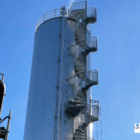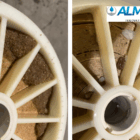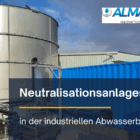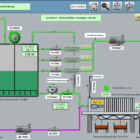A sludge trap is a technical device used in water and wastewater treatment for the mechanical separation of sedimentable solids from water or wastewater flows. It is an essential component in mechanical pre-treatment by retaining heavy particles such as sand, silt, mineral substances and coarse organic components. This relieves and protects the downstream treatment in sewage treatment plants, filtration systems or biological reactors.
Table of contents
Importance of the sludge trap
Protection of downstream systems:
- Prevents the accumulation of sand and solids in pumps, pipes and containers, which can lead to abrasion, blockages and mechanical damage.
- Protection of biological processes from excessive mineral loads that could damage microorganisms.
Improvement in operating efficiency:
- Removes sedimentable substances at an early stage, which increases the performance and service life of downstream cleaning systems such as sedimentation tanks, flotation systems or filters.
Resource conservation and disposal:
- Retention of solids to reduce the amount of sludge in subsequent treatment steps.
- Separate handling of separated sludge enables targeted disposal or recycling, e.g. in the construction industry.
Reduction of load peaks:
- The sludge trap buffers sudden solid inputs and ensures a more even load on the downstream systems.
How the sludge trap works
The sludge trap uses the physical properties of particles, such as density and sedimentation speed, to separate sedimentable materials from the water flow. This is done by slowing down the flow velocity, causing particles to sink due to gravity and settle at the bottom of the sludge trap.
1. hydraulic conditions
- The sludge trap is designed to reduce the flow velocity of the water (typically to 0.2-0.3 m/s), which promotes the separation of particles.
- Turbulence is minimized to prevent resuspension of the settled particles.
Types of sludge traps
Classic sludge collectors
- Areas of application:
- Municipal wastewater treatment plants, industrial wastewater systems.
- Structure:
- Rectangular or round tanks in which the water flows horizontally.
- Solids settle on the floor and are discharged via scrapers or screw conveyors.
- Advantages:
- Simple construction and cost-effective.
- Low energy requirement.
- Disadvantages:
- Limited efficiency with very fine particles.
Aerated sludge traps
- Functionality:
- The addition of air creates a controlled flow that promotes the sedimentation of sand and heavy particles while organic matter is kept in suspension.
- Areas of application:
- Municipal and industrial wastewater treatment plants with a high sand content.
- Advantages:
- Separation of sand and organic material.
- Prevents anaerobic conditions and odor formation.
- Disadvantages:
- Increased energy requirement due to ventilation.
Dynamic sludge traps
- Functionality:
- Use of rotational movements or centrifugal forces to accelerate the separation of solids.
- Areas of application:
- Industrial applications with high solids content.
- Advantages:
- High efficiency with smaller particles.
- Compact design.
- Disadvantages:
- Higher operating costs and maintenance costs.
Design of a sludge trap
The dimensioning of a sludge trap depends on the wastewater volume, the particle size and the desired separation performance. Typical parameters are
Separation efficiency:
- The aim is to separate at least 90 % of the particles with a size > 0.2 mm.
Hydraulic load:
- The maximum flow velocity in the sludge trap should not exceed 0.3 m/s in order to prevent resuspension.
Dwell time:
- Typical dwell times are between 30 seconds and 5 minutes, depending on the particle composition.
Cleaning mechanisms:
- Sludge scrapers or conveyor belts regularly remove the settled sludge.
Optimization and challenges
Optimization options
- Turbulence reduction:
- Use of flow breakers or cross-flow deflectors.
- Automation:
- Integration of sensors and automatic scraper systems for continuous cleaning.
- Combination with other procedures:
- Pre-filtration or chemical precipitation to support separation.
Challenges
- Fine particles:
- Sehr kleine Partikel (z. B. < 50 µm) sind schwer abzusetzen und erfordern zusätzliche Verfahren wie Flotation oder Filtration.
- Maintenance and sludge removal:
- Regular cleaning is necessary to maintain the separation performance.
- Fluctuating inlet conditions:
- Strongly varying wastewater volumes or particle compositions can impair efficiency.
Conclusion
The sludge trap is an indispensable component in the treatment of wastewater with a high solids content, acting as the first barrier to efficiently remove sedimentable solids and protect downstream systems. Careful design and the use of modern technologies can reduce operating costs and significantly increase the performance of wastewater treatment plants. Regular maintenance and adaptation to the specific conditions of the wastewater are crucial to ensure long-term high efficiency.
For further information on our products, please feel free to contact us at any time!








